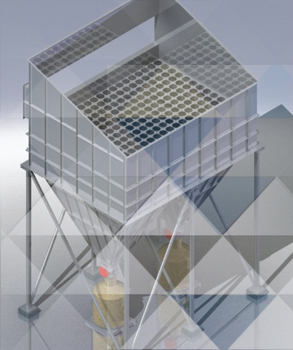Equipments
Multicyclones

Using the same concepts as a cyclone centrifuge, this piece of equipment is fitted with several “mini-cyclones” on the inside which play the same role as one cyclone, which is to set the gas in a centrifugal motion and drive the particulate matter to the bottom of the unit, where it remains until removal or transportation.
A separation occurs in this unit between incoming and centrifuged gas, improving the unit’s particulate matter capturing efficiency, as it would be hard for that material to blend in again and run through the outlet piping with the gas.
All components are manufactured with materials resistant to corrosion, oxidation and wear on the inner walls, which will vary according to gas and particulate matter composition type, as well as temperature.
With technology entirely developed on national soil, the equipment is manufactured with variances in types of material, from cast components to rolled products and stainless steel, requiring no imports whatsoever, all without prejudice to quality.
Both the inlet and outlet on the equipment can be aimed to better fit in the customer plant’s physical space. Once it is placed on the bottom of the hopper, the particulate matter remains there on stand-by until it is transported/packed later on.
Such transportation is also taken into consideration in the design development, so that a piece of equipment can be built with different hopper arrangements, which will identify the best outflow control type for this material, such as a screw conveyor, for longitudinal hoppers, or just a rotary valve, for pyramidal hoppers. Sets can even be put together with the two of these pieces of equipment, whether or not using a slide valve for added control.

